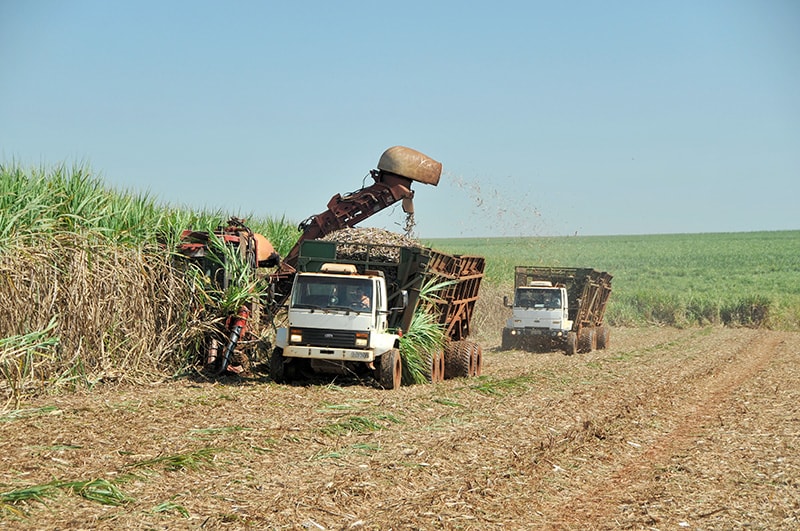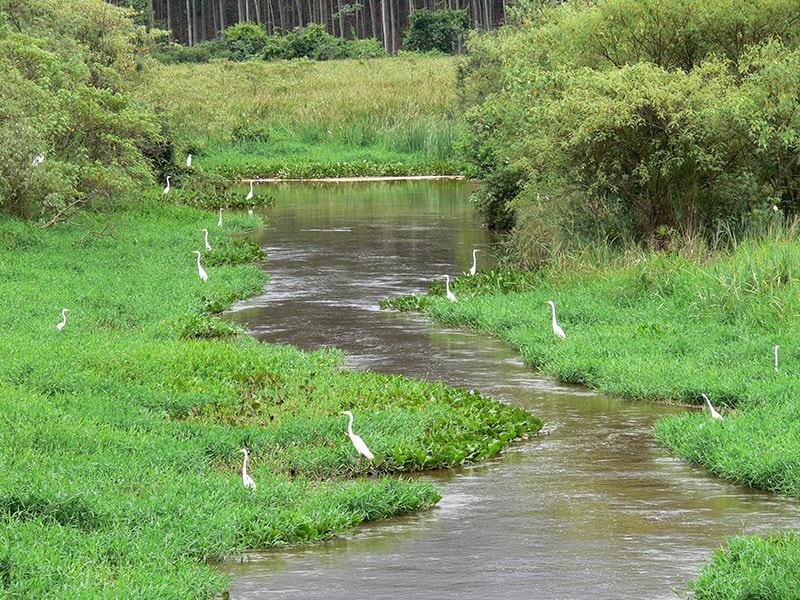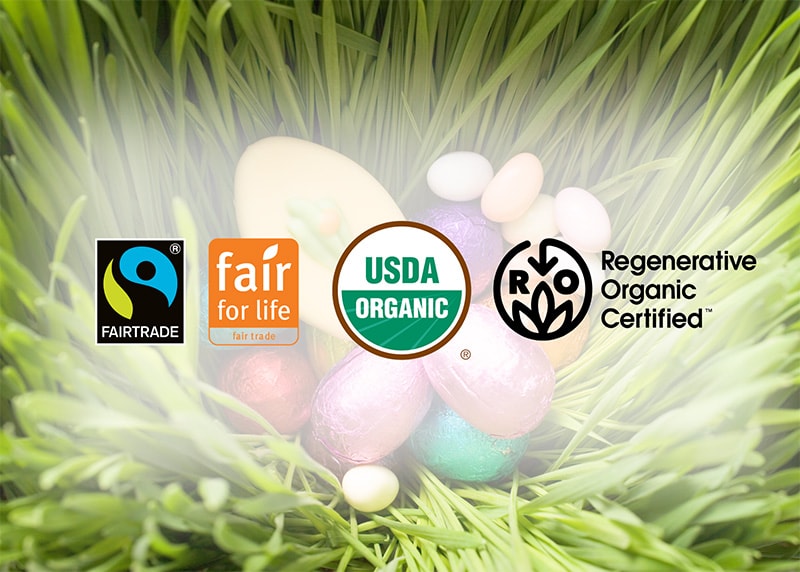The environmental impact of organic ingredient production: Why it matters for Easter and Beyond
04.01.2024 | Author: Global Organics | Category: Cane Sugar & Sweeteners, Chocolate & Cocoa, Caramel, Organic & Sustainability
Spring has sprung, and with it comes the eagerly anticipated arrival of Easter candy. This festive season brings with it a surge in candy demand, resulting in mind-boggling levels of consumption. The National Confectioners Association predicts that confectionery sales for the 2024 Easter season will exceed 5 billion dollars. In the United States alone, an astonishing amount of candy is purchased and devoured during this time, including 16 billion jelly beans, 700 million sugar-covered marshmallows, 90 million chocolate bunnies, and 80 million chocolate eggs. These numbers paint a picture of a candy-filled wonderland, captivating the taste buds of kids and adults alike.
The Role of Sugar in Easter Treats:
Sugar plays a significant role in creating the sweetness and appeal of these popular treats. For instance, a serving of 27 jelly beans contains 21 grams of sugar, adding to their irresistible allure. Similarly, a serving of five marshmallows packs 34 grams of sugar, making them a sweet delight that simply cannot be resisted. When considering the average sugar content in a single serving of jelly beans and marshmallows and comparing it to the total quantity of these candies purchased during Easter, we estimate that a staggering 38 million pounds of sugar is used for these two holiday candies annually.
The Environmental Toll of Traditional Easter Candy

While traditional Easter candy brings joy to many, it also comes with an often-overlooked environmental toll, primarily associated with the production of conventional sugar and chocolate. A recent study conducted during the 2021 Easter season in the UK, revealed that the production of chocolate eggs alone would result in the “release of 97,647 tons of carbon emissions into the atmosphere. This is equivalent to 100 return flights between London and New York or the weight of 13,949 elephants”. Additionally, conventional sugarcane cultivation involves deforestation and cane-burning practices, contributing to greenhouse gas emissions, the destruction of ecosystems, loss of biodiversity, and water pollution. According to the National Center for Biotechnology Information, the effects of sugar cultivation differ depending on the location, but the production of 1 kilogram (approximately 2.2 pounds) of conventionally refined sugar typically necessitates 1,782 liters of water (equivalent to more than 470 gallons). In regions where crop residues are still burned, a ton (1,000 kg) of conventional sugar emits approximately 241 kg of carbon dioxide equivalent during the burning process. The heavy reliance on more than fifty pesticides in sugarcane farms further exacerbates soil degradation and biodiversity loss.
Promoting Sustainable Alternatives:

Promoting sustainable and eco-friendly alternatives for Easter candy production is crucial. This involves using organic and fair-trade ingredients and exploring innovative agricultural practices to reduce the ecological impact of sugar production. One leading company in organic sugar production is Native, a long-time partner of Global Organics in Brazil. Native has developed innovative agricultural practices, including a unique mechanical harvester that prevents soil compaction and eliminates pre-harvest burning. They also avoid artificial nitrogen-based fertilizers, toxic pesticides, and herbicides, relying on hand weeding and biological controls instead. Native is committed to reforestation, planting millions of trees to create forests and greenways that support biodiversity.

Their mill is 100% carbon neutral, generating surplus energy that can sustain a city of 500,000 people. Notably, their cogeneration efforts alone save over 25,000 tons of carbon dioxide annually, Native's most recent achievement of the gold status for the Regenerative Organic Agriculture Certification signifies that they have successfully met the highest standards for organic farming and production, encompassing the well-being of the land, biodiversity, farmers, and their community. If Easter jelly beans and marshmallows used Native organic sugar, we could avoid 2 million pounds of synthetic fertilizer, prevent over 23 thousand pounds of pesticides, insecticides, and herbicides, remove over 20 million pounds of CO2, and restore 7 thousand acres of soil.
The Power of Consumer Choices:
Consumer choices have a profound impact on our food system and its environmental consequences, particularly during holidays like Easter. A statistic from the National Confectioners Association reveals that 82% of candy consumers are interested in a brand's practices and commitments to both people and the planet. This growing awareness underscores the importance of transparency and sustainability in the food industry. By seeking information about a brand's ethical and environmental initiatives, consumers can make informed decisions that align with their values and contribute to a more sustainable and responsible food system.

As spring arrives earlier each year, it is critical to start considering the impact of our choices on the planet. Each dollar spent by consumers serves as a vote that has the potential to shape our future in a meaningful way. Climate change continues to have devastating ecological consequences, affecting pollinators, wildlife including Easter bunnies, and the delicate balance of ecosystems. As we celebrate Easter and look ahead to Earth Day, let's remember the power we hold as consumers and manufacturers. By prioritizing organic and sustainable ingredients in our holiday candy choices, we can create a sweeter future for both ourselves and the environment.
References:
Alexander, Gemma. “The Hidden Environmental Cost of Added Sugars.” Earth911, 27 Aug. 2022, earth911.com/food-beverage/the-hidden-environmental-cost-of-added-sugars/.
Coleman, Jude. “Spring Is Starting Earlier--It’s Not Your Imagination.” Scientific American, 20 Feb. 2024, www.scientificamerican.com/article/spring-is-starting-earlier-its-not-your-imagination/.
“The Eco-Egg Report: The Most Sustainable Easter Eggs Revealed in New Study.” Uswitch, 26 March 2021, www.uswitch.com/gas-electricity/eco-eggs-report/#:~:text=Per%201kg%20of%20chocolat e%2C%20we,or%2097%2C647%20tonnes%20of%20CO2e.
Ilgar, Oyku. “SAP Brandvoice: Sustainable Easter: Chocolate’s Biggest Day Hops into New Supply Chain Territory.” Forbes, Forbes Magazine, 10 Aug. 2023, https://www.forbes.com/sites/sap/2022/04/08/sustainable-easter-chocolates-biggest-day-hops-into-new-supply-chain-territory/?sh=40ecfbe81160.
“Sweet Insights: State of Treating 2020.” National Confectioners Association, candyusa.com/wordpress/wp-content/uploads/2020/04/StateOfTreating_2020_BiteSized_ FINAL_compressed.pdf.
David Johnson, “Sweet Easter Facts.” Infoplease, 22 March 2021, www.infoplease.com/culture-entertainment/holidays/sweet-easter-facts#:~:text=Each%20Eas ter%20season%2C%20Americans%20buy,popular%20non%2Dchocolate%20Easter%20candy.


